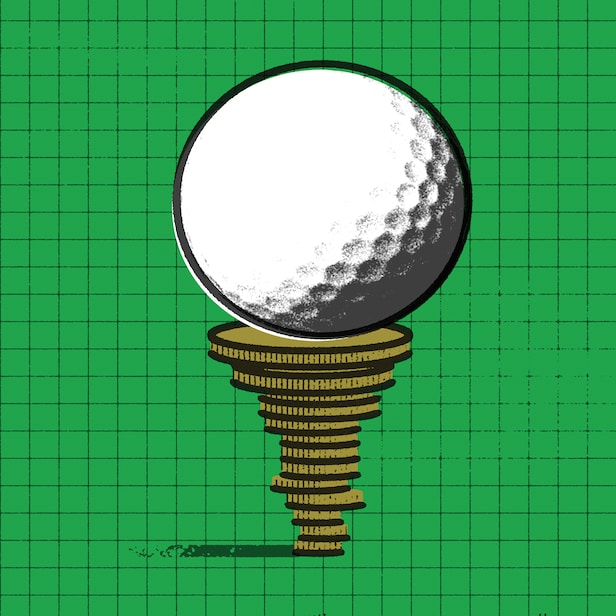Some recent maneuvers on the PGA Tour bring to mind the time Howard Hughes, the richest man in America, tried to buy pro golf. He wanted Arnold Palmer and Jack Nicklaus to play in Las Vegas at his Desert Inn but was turned down. “They didn’t need gambling on the landscape of the careers they were then painting,” explained the writer Charles Price. Later when Hughes was building his casino empire in an industry largely controlled by the Mob, he proposed to “establish Las Vegas as the Golf Capital of the World.” In a memo that became public, he wrote: “I am prepared to put up purses that will far exceed anything yet—$500,000 and even $1 million tournaments!” This was circa 1970, when total prize money for the U.S. Open was less than $200,000. Hughes abandoned this plan, too.
Money guys have come and gone in pro golf. Nicklaus was offered $1 million to play made-for-TV matches against Johnny Miller, but he refused because he said it would hurt the tour. Golf has always been blessed with stars who put the game above themselves.
Greg Norman once danced with Fox and Rupert Murdoch but failed to create a rival world tour to compete against the PGA Tour, and now Greg is back again as CEO of an effort funded by the Saudi government and Mohammad bin Salman. Enormous wealth is promised. The Washington Post calls it “blood money.” A golfer who has lived in the Middle East told me: “MBS’s government is like a jack-in-the-box. Things can be going along fine, and then out of nowhere something crazy will pop out. You’ll never see it coming. But players better be prepared for the reporters’ questions and how comfortable they are ignoring them.”
Today’s tour players look longingly at the guaranteed contracts of other sports stars, but they need to keep in mind: The NFL’s total revenues (pre-pandemic) were about $16 billion, MLB $10.7 billion, NBA $8.3 billion and the PGA Tour $1.5 billion (2022). Pro golf is a minor sport by comparison.
Player prize money has grown aggressively, but bonus compensation fueled by new media-rights agreements is kicking in. In the past five years, yearly incentive plans have risen from $66.2 million to $185.3 million, up 180 percent.
I remember the comedian Gary McCord coming up to Nicklaus and saying, “Jack, I’ve got an idea that will make you rich and famous.” Like Jack, today’s stars are already rich and famous, and they’re likely to get even richer in the next few years if they don’t upset the unique balance golf enjoys. The late Mark McCormack, founder of IMG, told me golf was better than other sports because it has a power structure with the four men’s major championships controlled by different governing bodies separate from the PGA Tour—“It’s a checks-and-balances system that works to the benefit of the game,” he said.
Commissioner Deane Beman (1974- ’94) chafed under these limitations, but he made two important contributions: He set up the PGA Tour as a nonprofit underpinned by charity, and he was very good at generating more revenue than he spent on prize money, so a treasure chest was created that his successors, Tim Finchem and Jay Monahan, expertly grew. Cash management gave the tour stability and allowed purses to increase year after year through economic downturns, vacillating sponsors, September 11 and the pandemic, so pro golfers have been insulated from the real world. As Chip Beck said about a $360,000 first prize: “Some people have to work all year to make that kind of money.” And he said it in 1988.
Where does golf ’s strength come from? The tour has been the beneficiary of spiraling media-rights fees (full disclosure: Golf Digest’s owner, Discovery Inc., is one of those media partners), corporate sponsorship and good strategic leaders. One example is how the commissioners have handled appearance fees, which gets to the heart of the current challenge.
Tournaments operate under the illusion that every player is equal, but actually the top stars bring in the fans and media. It’s the 20-80 rule—20 percent of the players generate 80 percent of the revenue. Without stars, the business model doesn’t work, but the tour also needs journeymen to put on the whole circus.
Tournament sponsors can assure that the stars show up by offering guaranteed income. But the tour doesn’t like the look and long ago banned pay-for-play. Corporations need the marketing muscle of the stars beyond the one week of a tournament, so the tour finessed a compromise. Sponsors like Workday, RBC, MasterCard and Zurich hire a team of ambassador players who appear in commercials, entertain clients and, by the way, play in their tournaments. Appearance fees by another name became win-win-win for the players, the sponsors and the tour.
The new Player Impact Program (PIP) that pays a $40-million bonus to the game’s top influencers is another smart move by the PGA Tour to keep PIPpy Mickelson and other stars in check. I wouldn’t be surprised if the Tournament Players Clubs were sold off to keep rewarding the pros who move the needle. Sports income is on the rise everywhere—from the 2022 U.S. Women’s Open purse almost doubling to the NCAA allowing college athletes to sell endorsements and merchandise.
The NFL allots just less than 50 percent of its revenue to player compensation; the PGA Tour looks good by comparison with 55 percent—$641.7 million annually. That’s about $429 million in 2022 official prize money, including the majors ($379.3 million without majors), up 16.9 percent from 2021.
It’s a good time for the pros to pause and appreciate. When tour players already rich and famous are offered deals that seem too good to be true, they just need to ask the old question: What would Jack and Arnie do?
